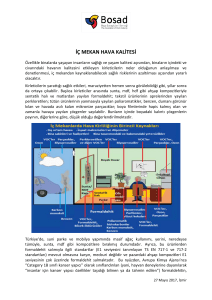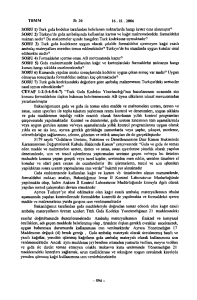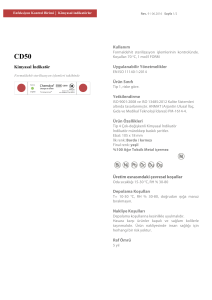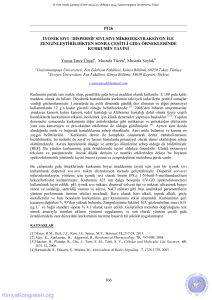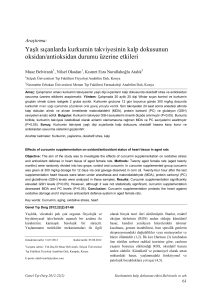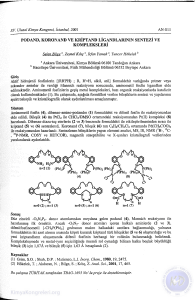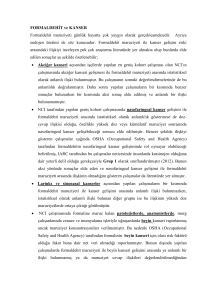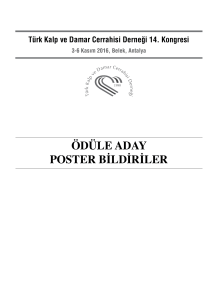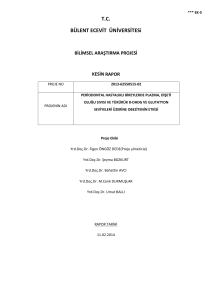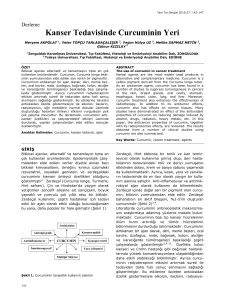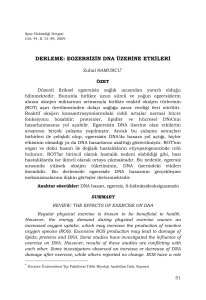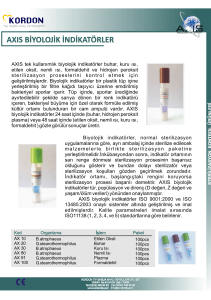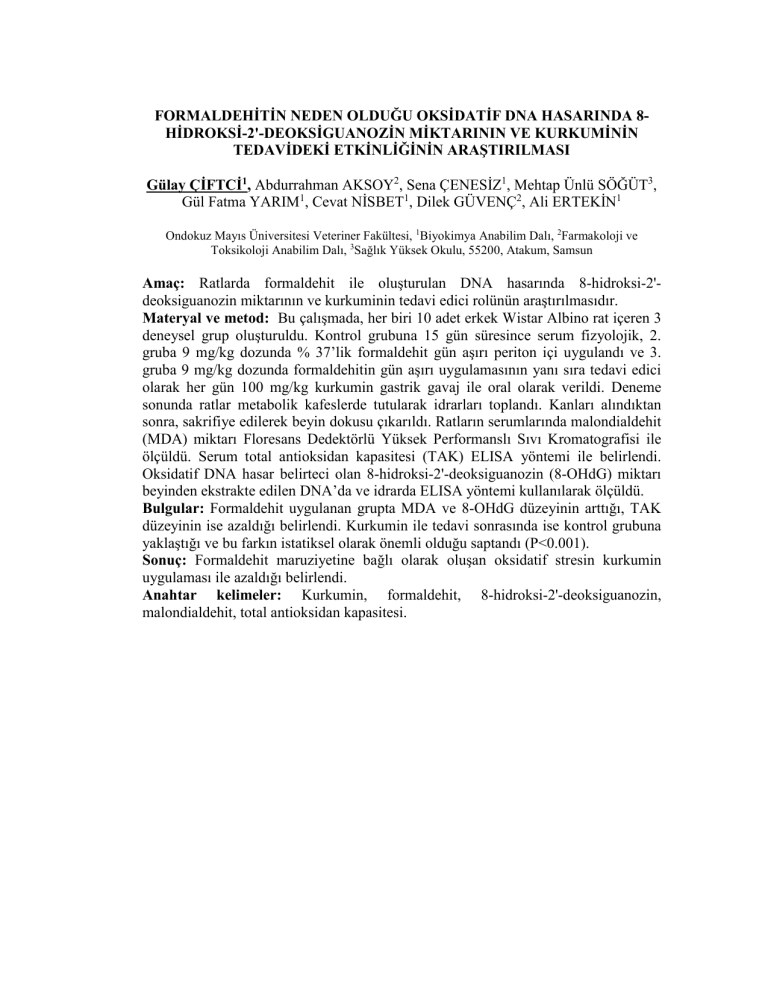
FORMALDEHİTİN NEDEN OLDUĞU OKSİDATİF DNA HASARINDA 8HİDROKSİ-2'-DEOKSİGUANOZİN MİKTARININ VE KURKUMİNİN
TEDAVİDEKİ ETKİNLİĞİNİN ARAŞTIRILMASI
Gülay ÇİFTCİ1, Abdurrahman AKSOY2, Sena ÇENESİZ1, Mehtap Ünlü SÖĞÜT3,
Gül Fatma YARIM1, Cevat NİSBET1, Dilek GÜVENÇ2, Ali ERTEKİN1
Ondokuz Mayıs Üniversitesi Veteriner Fakültesi, 1Biyokimya Anabilim Dalı, 2Farmakoloji ve
Toksikoloji Anabilim Dalı, 3Sağlık Yüksek Okulu, 55200, Atakum, Samsun
Amaç: Ratlarda formaldehit ile oluşturulan DNA hasarında 8-hidroksi-2'deoksiguanozin miktarının ve kurkuminin tedavi edici rolünün araştırılmasıdır.
Materyal ve metod: Bu çalışmada, her biri 10 adet erkek Wistar Albino rat içeren 3
deneysel grup oluşturuldu. Kontrol grubuna 15 gün süresince serum fizyolojik, 2.
gruba 9 mg/kg dozunda % 37’lik formaldehit gün aşırı periton içi uygulandı ve 3.
gruba 9 mg/kg dozunda formaldehitin gün aşırı uygulamasının yanı sıra tedavi edici
olarak her gün 100 mg/kg kurkumin gastrik gavaj ile oral olarak verildi. Deneme
sonunda ratlar metabolik kafeslerde tutularak idrarları toplandı. Kanları alındıktan
sonra, sakrifiye edilerek beyin dokusu çıkarıldı. Ratların serumlarında malondialdehit
(MDA) miktarı Floresans Dedektörlü Yüksek Performanslı Sıvı Kromatografisi ile
ölçüldü. Serum total antioksidan kapasitesi (TAK) ELISA yöntemi ile belirlendi.
Oksidatif DNA hasar belirteci olan 8-hidroksi-2'-deoksiguanozin (8-OHdG) miktarı
beyinden ekstrakte edilen DNA’da ve idrarda ELISA yöntemi kullanılarak ölçüldü.
Bulgular: Formaldehit uygulanan grupta MDA ve 8-OHdG düzeyinin arttığı, TAK
düzeyinin ise azaldığı belirlendi. Kurkumin ile tedavi sonrasında ise kontrol grubuna
yaklaştığı ve bu farkın istatiksel olarak önemli olduğu saptandı (P<0.001).
Sonuç: Formaldehit maruziyetine bağlı olarak oluşan oksidatif stresin kurkumin
uygulaması ile azaldığı belirlendi.
Anahtar kelimeler: Kurkumin, formaldehit, 8-hidroksi-2'-deoksiguanozin,
malondialdehit, total antioksidan kapasitesi.
INVESTIGATION of the AMOUNT of 8-HYDROXY-2′-DEOXYGUANOSINE
and THERAPEUTIC ROLE of CURCUMIN in OXIDATIVE DNA DAMAGE
CAUSED by FORMALDEHYDE
Gülay ÇİFTCİ1, Abdurrahman AKSOY2, Sena ÇENESİZ1, Mehtap Ünlü SÖĞÜT3,
Gül Fatma YARIM1, Cevat NİSBET1, Dilek GÜVENÇ2, Ali ERTEKİN1
Department of 1Biyochemistry, 2Pharmacology and Toxicology, Faculty of Veterinary Medicine,
3
High School of Health, Ondokuz Mayis University, 55200, Atakum, Samsun
Objective: Investigation of the amount of 8-hydroxy-2-deoxyguanosine and
therapeutic role of curcumin in oxidative DNA damage caused by formaldehyde in
rats.
Material and method: In this study, three experimental groups were created which
each of them including of 10 male Wistar Albino rats. The control group was applied
physiological saline during 15 days, the second group was applied 37 %
formaldehyde intraperitoneally at a dose of 9 mg/kg group every other day. The third
group was applied 9 mg/kg formaldehyde intraperitoneally every other day as well as
curcumin as a therapeutic was applied orally by gavage 100 mg/kg per day. At the
end of the trial urine was collected by keeping the rats in metabolic cages. After
blood sampling, the brain tissue was removed by sacrificing. The quantity of
malondialdehyde (MDA) was measured by High Performance Liquid
Chromatography with fluorescence detection in the serum of rats. Serum total
antioxidant capacity (TAC) was measured by ELISA in serum. The quantities of 8hydroxy-2-deoxyguanosine (8-OHdG) which is the biomarker of oxidative DNA
damage, were measured by using ELISA method in urine and in extracted DNA from
the brain.
Results: The levels of MDA and 8-OHdG were increased, the TAC levels were
reduced in the formaldehyde treated group. After treatment with curcumin the
difference approach to the control group and its statistical importance were found
(P<0.001).
Conclusion: As a result, the oxidative stress which is formed by exposuring
formaldehyde were reduced with the application of curcumin were determined.
Keywords:
Curcumin,
formaldehyde,
8-hydroxy-2-deoxyguanosine,
malondialdehyde, total antioxidant capacity.

